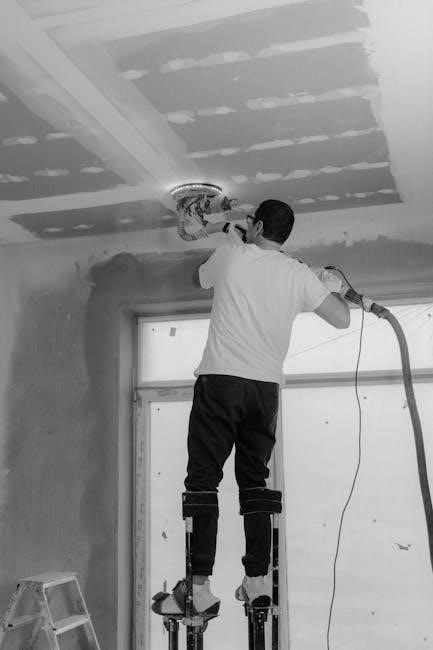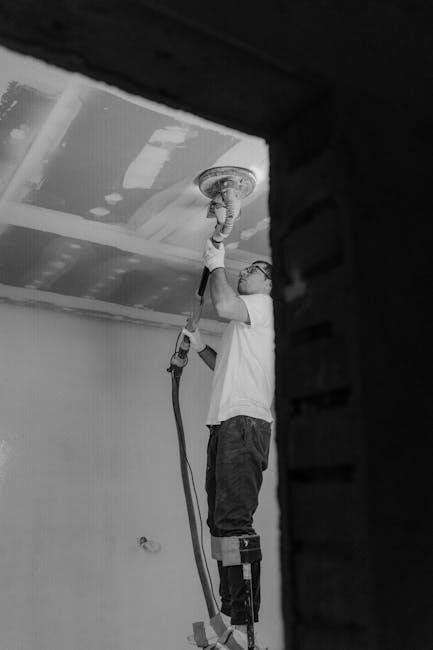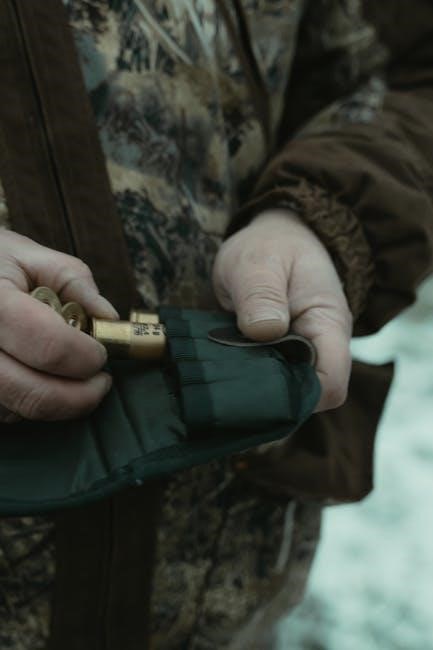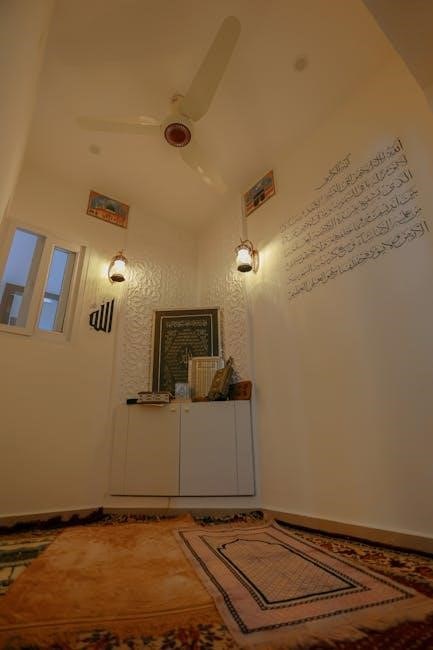
The Hunter Ceiling Fan Manual PDF provides essential guidance for installation, operation, and maintenance. It ensures optimal performance and safety, offering detailed instructions and troubleshooting tips.
1.1 Importance of the Manual for Installation and Operation
The Hunter Ceiling Fan Manual PDF is essential for ensuring proper installation and operation. It provides detailed step-by-step instructions, safety guidelines, and troubleshooting tips to help users avoid common mistakes. Without the manual, installing or operating the fan correctly becomes challenging, potentially leading to safety hazards or reduced performance. The manual also includes specific instructions for various Hunter fan models, ensuring compatibility and optimal functionality. By following the manual, users can enjoy energy efficiency, smooth operation, and extended lifespan of their ceiling fan. It’s a crucial resource for both new and experienced users.
1.2 Overview of Hunter Ceiling Fan Models Covered in the Manual
The Hunter Ceiling Fan Manual PDF covers a wide range of models, including popular designs like the Hunter Hardaway, WhisperWind, and low-profile ceiling fans. Each model-specific manual provides detailed instructions tailored to its unique features, such as energy-saving motors, smart home compatibility, and light kit installations. Whether you own a traditional or modern Hunter fan, the manual ensures compatibility and ease of use. It includes diagrams, wiring guides, and operation tips specific to each model, helping users maximize performance and enjoy a seamless experience with their ceiling fan.
1.3 Why Reading the Manual is Crucial for Optimal Performance
Reading the Hunter Ceiling Fan Manual PDF is essential for optimal performance and safety. It provides clear instructions for installation, operation, and maintenance, ensuring your fan functions efficiently. The manual highlights energy-saving features, remote control settings, and troubleshooting tips, helping you address common issues. By following the guidelines, you can maximize airflow, reduce noise, and extend the fan’s lifespan. Proper setup and understanding of features like timers and smart integration are also covered, making it a vital resource for getting the most out of your Hunter ceiling fan.
1.4 Where to Find the Hunter Ceiling Fan Manual PDF
The Hunter Ceiling Fan Manual PDF is readily available on the official Hunter Fan website. Visit the support section, enter your model number, and download the PDF. You can also find it on authorized retailers’ websites or through Hunter’s customer service. Additionally, third-party databases like ManualsLib or ManualsOnline may host the manual. Ensure you download from a trusted source to avoid incorrect or outdated information. The manual is a valuable resource for troubleshooting, installation, and understanding your fan’s features and warranty details.

Installation Instructions
Begin by turning off the power supply. Mount the fan securely, following the manual’s wiring diagrams. Connect the wires carefully and test the fan after installation.
2.1 Pre-Installation Checklist
Before starting, ensure the ceiling is sturdy enough to support the fan’s weight. Gather all tools and hardware from the box. Turn off the power supply at the circuit breaker. Verify the fan’s compatibility with your ceiling type (standard, sloped, or vaulted). Check for any obstructions in the installation area. Ensure all electrical connections are safe and meet local codes. Review the wiring diagram to understand the connections. Familiarize yourself with the remote control functions if applicable. Lastly, double-check that all parts are included and undamaged.
2.2 Step-by-Step Installation Process
Begin by turning off the power supply at the circuit breaker. Remove any existing light fixtures and carefully lower them. Install the mounting bracket onto the ceiling outlet box, ensuring it is securely fastened. Hang the fan motor from the bracket using the provided hook. Connect the fan’s wiring to the household wiring, matching black to black and white to white. Secure the fan housing to the bracket. Attach the blades and light kit (if applicable) following the manual’s instructions. Finally, turn the power back on and test the fan’s operation at all speed settings to ensure proper function.
2.3 Wiring Diagrams and Connections
Refer to the wiring diagrams in the Hunter ceiling fan manual for precise connections. Identify the black (live), white (neutral), and copper (ground) wires. Connect the fan’s black wire to the household black wire and the white wire to the neutral. Ground the copper wire to the mounting bracket. If your fan includes a light kit or remote, follow the manual’s specific wiring instructions for these components. Ensure all connections are secure and insulated. Double-check the wiring before restoring power to avoid electrical hazards. Proper wiring ensures safe and efficient operation of your ceiling fan.
2.4 Common Installation Mistakes to Avoid
When installing your Hunter ceiling fan, avoid common mistakes like incorrect wiring connections or not turning off the power. Ensure the fan is properly balanced to prevent wobbling. Do not overtighten screws, as this may damage the motor or mounting bracket. Verify that the fan is securely attached to the ceiling to avoid instability. Additionally, ensure the light kit (if included) is installed correctly to prevent electrical issues. Always follow the manual’s instructions for wiring diagrams and connections to avoid safety hazards. Proper installation ensures smooth operation and longevity of your ceiling fan.

Operating the Ceiling Fan
Operating your Hunter ceiling fan involves using the remote control to adjust speed settings, turn the light kit on/off, and access energy-saving features for optimal performance.
3.1 Understanding the Remote Control Functions
The remote control for your Hunter ceiling fan allows you to adjust fan speed, turn the light kit on/off, and access additional features like dimming or timer settings. To ensure proper functionality, the remote must be paired with the fan’s receiver. This process typically involves turning the fan’s power off, waiting 15 seconds, and then turning it back on to reset the connection. The remote’s buttons are designed for intuitive operation, with clear labels for speed adjustments and light control. If issues arise, refer to the troubleshooting section for guidance on reprogramming or resetting the remote. Proper use enhances your fan’s performance and convenience.
3.2 Adjusting Fan Speed Settings
Hunter ceiling fans offer multiple speed settings to customize airflow according to your needs. Use the remote control to switch between high, medium, and low speeds for optimal comfort. High speed maximizes cooling during summer, while low speed provides gentle air circulation. Some models include reverse operation for winter use, which circulates warm air without cooling the room. Adjusting fan speed is straightforward: press the speed button on the remote until your desired setting is reached. Proper speed adjustment enhances energy efficiency and ensures year-round comfort, making it easy to tailor your fan’s performance to any season or activity level.
3.3 Using the Light Kit (If Applicable)
The Hunter ceiling fan light kit enhances functionality by providing adjustable illumination. Typically, it uses three 60W candelabra bulbs or energy-efficient LEDs, as specified in the manual. To operate, use the remote control to adjust brightness or toggle the light on/off. Ensure bulbs are correctly seated and meet wattage requirements to avoid overheating. Regularly clean the glass cover for optimal light distribution. Always refer to the manual for specific bulb recommendations to maintain safety and performance.
3.4 Energy-Saving Features and Settings
Hunter ceiling fans are designed with energy efficiency in mind. The WhisperWind motor ensures quiet, powerful airflow while using minimal energy. Many models feature programmable timers and energy-saving modes that automatically adjust speed based on temperature. LED light kits are also available, offering long-lasting, low-wattage illumination. To maximize energy savings, use the remote control to toggle between eco-friendly settings or enable the fan’s reverse function, which circulates warm air during winter. These features not only reduce energy consumption but also lower utility bills without compromising comfort or performance.

Maintenance and Troubleshooting
Regular cleaning and blade balancing ensure smooth operation. Lubricate moving parts annually and address wobbling or noise promptly for optimal performance and longevity of your ceiling fan.
4.1 Cleaning the Fan Blades and Housing
Cleaning the fan blades and housing regularly is crucial for maintaining airflow efficiency and aesthetics. Turn off the power and use a soft cloth to wipe down the blades, removing dust and debris. For tougher stains, a mild detergent solution can be used, but avoid harsh chemicals that might damage the finish. The housing should be cleaned similarly, ensuring no dust buildup interferes with the fan’s operation. Regular cleaning prevents dust from circulating in the air, improving indoor air quality and keeping your fan running smoothly.
4.2 Balancing the Fan Blades for Smooth Operation
Balancing the fan blades ensures smooth operation and prevents wobbling or noise. Start by turning off the power and checking each blade for alignment. If uneven, gently adjust the blades to level them. For persistent imbalance, use a balancing kit (often included with Hunter fans) to weigh the blades. Attach the weights to the lighter blade until the fan runs evenly. Tighten all screws securely after adjustments. Regular balancing maintains optimal performance and reduces wear on the motor. Annual checks are recommended to ensure stability and quiet operation year-round.
4.3 Lubricating Moving Parts
Lubricating moving parts ensures your Hunter ceiling fan operates smoothly and quietly. Use a silicone-based lubricant to avoid attracting dust and ensure longevity. Turn off the power before starting. Locate the motor bearings and apply a small amount of lubricant—excess can attract dust. Let it sit a few minutes to seep in. After lubrication, test the fan on different speeds to ensure smooth operation. Regular lubrication, ideally every six months, prevents wear and tear. Always use the recommended lubricant type to avoid damage. Clean the fan blades and housing before lubricating for optimal efficiency and effectiveness.
4.4 Troubleshooting Common Issues
Troubleshooting common issues with your Hunter ceiling fan can resolve problems quickly. If the fan doesn’t turn on, check the power source and ensure the remote is paired correctly. For wobbling, balance the blades using the provided balancing kit. Noise issues may indicate loose screws or worn bearings. If the light kit flickers, ensure bulbs are securely installed and compatible. For remote control problems, reset the remote by turning the power off and on. Consult the manual for detailed solutions and avoid DIY repairs that could void the warranty. Regular maintenance can prevent many of these issues.
Remote Control Programming
Programming your Hunter ceiling fan remote involves syncing it with the fan. Turn off the power, wait 15 seconds, then turn it back on. This resets and pairs the remote properly, ensuring smooth operation. Refer to the manual for detailed instructions and troubleshooting tips.
5.1 Pairing the Remote with the Fan
Pairing the remote with your Hunter ceiling fan is a straightforward process. Start by turning off the fan and disconnecting power at the circuit breaker. Wait approximately 15 seconds to ensure any residual power is discharged. Then, restore power and test the remote by pressing the fan’s speed buttons. If the fan doesn’t respond, reset the remote by removing and reinserting the batteries. This method ensures proper pairing and reestablishes communication between the remote and the fan’s receiver. Always refer to the manual for specific instructions to avoid any pairing issues.
5.2 Resetting the Remote Control
Resetting the remote control is a simple process to restore its functionality. Begin by removing the batteries from the remote and wait for 15 seconds. Reinsert the batteries and test the remote by pressing the fan speed buttons. If issues persist, turn off the fan’s power at the circuit breaker for 15 seconds, then restore power and test the remote again. This reset procedure ensures the remote reconnects with the fan’s receiver, resolving most connectivity problems. Always follow the manual’s guidelines for resetting to maintain optimal performance and avoid further complications.
5.3 Customizing Remote Settings
Customizing your Hunter ceiling fan remote settings allows for personalized control over fan speed, lighting, and energy-saving features. To customize, ensure the remote is paired with the fan. Access the remote’s battery compartment and press and hold the “Pair” or “Reset” button for 3-5 seconds until the fan responds. Use the remote’s buttons to adjust speed settings or activate energy-saving modes. Some models may require syncing with a smart kit for advanced features. Always refer to the manual for specific instructions tailored to your fan model. Customizing enhances functionality and ensures seamless operation according to your preferences.
5.4 Replacing the Remote Batteries
To ensure uninterrupted operation, replace the remote batteries when they weaken. Open the remote’s battery compartment, typically located on the back. Remove the old batteries and insert new ones, matching the type specified in the manual. Align the positive and negative terminals correctly. Close the compartment securely. After replacing, test the remote by adjusting the fan speed or turning the light on/off. Proper battery replacement maintains seamless control and prevents signal loss. Refer to the manual for specific battery type recommendations to ensure optimal performance and longevity of your Hunter ceiling fan remote.

Safety Guidelines
Always turn off power before installation or maintenance. Avoid operating the fan near water or in hazardous locations. Follow all electrical safety precautions to ensure safe operation.
6.1 Safety Precautions During Installation
Before starting, ensure the power is turned off at the circuit breaker. Wear safety gloves and eyewear to protect against debris. Avoid installing near water sources or in humid environments. Use a sturdy ladder and maintain three points of contact. Never touch electrical components without proper insulation. Follow the manual’s wiring diagrams carefully to prevent short circuits. Keep children and pets away from the work area. If unsure, consult a licensed electrician. Proper installation ensures safe and efficient fan operation, reducing risks of accidents or malfunctions.
6.2 Operating the Fan Safely
Always turn off the fan before cleaning or performing maintenance. Ensure the fan is securely installed to prevent wobbling or falling. Keep children away from the fan while it’s in operation. Avoid touching the blades or housing while the fan is running. Use the remote control or wall switch to adjust settings safely. Never operate the fan near open flames or sparks. Keep the area around the fan clear of obstructions. Regularly inspect the blades for dust buildup and clean them with a soft cloth. Avoid operating the fan in extreme temperatures or humidity unless specified in the manual.
6.3 Electrical Safety Tips
Always turn off the power at the circuit breaker before handling any electrical components of the fan. Ensure all wires are securely connected to avoid short circuits. Never touch electrical parts with wet hands or while standing on a damp surface. Use a licensed electrician if unsure about wiring. Keep the fan and its components away from water to prevent electrical hazards. Avoid overloading the circuit with additional devices. Regularly inspect wires for damage or fraying. Use the correct gauge of wire for connections. Ground the fan properly to prevent electrical shocks. Follow all local electrical codes and regulations.
6.4 Emergency Shutdown Procedures
In case of an emergency, immediately turn off the ceiling fan using the remote control or wall switch. If the fan malfunctions or starts operating erratically, switch off the power at the circuit breaker. Do not attempt to repair the fan while it is in motion. Disconnect the power supply completely before inspecting or servicing. If the issue persists, contact a licensed electrician or Hunter customer support. Ensure the fan is stationary and cool before any further action. Always prioritize safety to prevent accidents or further damage.

Warranty and Support
Hunter Ceiling Fans come with a comprehensive warranty, ensuring coverage for parts and labor. Register your fan for extended support and access to dedicated customer service assistance.

7.1 Understanding the Warranty Terms
Hunter Ceiling Fans are backed by a robust warranty program, ensuring long-term reliability. The motor is typically covered for life, while parts and accessories have a limited warranty. Understanding the terms is crucial for knowing what is covered and for how long. The warranty generally excludes damage from improper installation or misuse. It’s important to review the manual for specific details, as terms may vary by model. If issues arise, refer to the manual or contact Hunter’s customer support for assistance. Proper registration and adherence to maintenance guidelines can maximize warranty benefits and ensure optimal performance. Always check for any regional variations in warranty terms.
7.2 Registering Your Ceiling Fan
Registering your Hunter Ceiling Fan is a straightforward process that ensures warranty validation and access to exclusive customer support. To register, visit the official Hunter website and navigate to the registration section. Provide the required details, including your contact information, fan model number, and purchase date. Once submitted, you’ll receive confirmation of your registration. This step is crucial for activating warranty benefits and receiving personalized support. For any assistance during registration, refer to the manual or contact Hunter’s customer service team. Proper registration ensures seamless service and enhances your ownership experience. Keep your registration confirmation for future reference.
7.3 Contacting Hunter Customer Support
For any inquiries or assistance, Hunter Customer Support is readily available to help. You can reach them via phone, email, or through the official website’s contact form. Visit the Hunter website to find the dedicated support section, which includes contact details and operating hours. Be prepared to provide your fan’s model number and serial number for efficient service. The support team is trained to address installation issues, troubleshooting, and warranty-related questions. Additionally, live chat options may be available for immediate assistance. Contacting Hunter Support ensures you receive accurate guidance and solutions tailored to your ceiling fan needs. Their expertise guarantees a smooth ownership experience.
7.4 Frequently Asked Questions (FAQs)
The Hunter Ceiling Fan Manual PDF includes a comprehensive FAQ section addressing common queries. Topics range from installation and operation to troubleshooting and warranty. FAQs cover issues like remote control pairing, speed settings, and light kit installation. Users can find solutions for noise issues, wobbling fans, and energy efficiency. The FAQ section also provides guidance on replacing parts and understanding warranty terms. It serves as a quick reference for resolving common problems and optimizing fan performance. This section ensures users can address concerns without needing to contact support, saving time and effort. The FAQs are designed to enhance the overall ownership experience.

Accessories and Upgrades
- Explore compatible accessories like light kits and smart fan upgrades.
- Enhance functionality with remote controls and interchangeable designs.
- Customize your fan’s look with optional blade sets and finishes.
- Upgrade to energy-efficient LED light kits for improved performance.
8.1 Compatible Accessories for Your Hunter Fan
Hunter ceiling fans offer a variety of compatible accessories to enhance functionality and aesthetics. Light kits, LED upgrades, and remote controls are popular additions. Smart fan kits enable voice control and app-based operation. Design customization options include interchangeable blade sets, glass shades, and finish upgrades. Energy-efficient LED bulbs and dimmer switches are also available. These accessories ensure your fan meets your lifestyle needs while maintaining optimal performance. Refer to the manual for compatibility details and installation guidance. Upgrading your fan with these accessories can elevate its functionality and style seamlessly.
8.2 Upgrading to a Smart Fan Kit
Upgrading your Hunter ceiling fan to a smart fan kit enhances its functionality with modern technology. Smart kits allow voice control via smart home systems and app-based operation for convenience. Compatibility is crucial; ensure the kit matches your fan model. Installation typically involves replacing the receiver and syncing the system. This upgrade enables features like scheduled operation, energy monitoring, and seamless integration with other smart devices. Refer to the manual for specific instructions and compatibility details. Upgrading to a smart fan kit modernizes your ceiling fan, offering advanced control and efficiency for a smarter home experience. The process is straightforward and highly rewarding.
8.3 Adding a Light Kit to Your Fan
Adding a light kit to your Hunter ceiling fan enhances its functionality by providing additional lighting. Ensure the light kit is compatible with your fan model for proper installation. Follow the manual’s instructions to install the kit safely and correctly. Typically, this involves attaching the light fixture to the fan’s housing and connecting the wiring. Use the recommended bulb type, such as LED, for energy efficiency. The light kit adds ambiance and improves illumination in your space. Always turn off the power before starting the installation to avoid electrical hazards. This upgrade is a great way to maximize your fan’s versatility and aesthetic appeal.
8.4 Customizing the Fan’s Design
Customizing your Hunter ceiling fan’s design allows you to match your home decor. Replace the fan blades with interchangeable designs or swap the finish to complement your room’s style. Install glass globe light covers or trim kits for a polished look. Use Hunter’s wide range of design elements, such as blade sets and finish options, to create a unique aesthetic. Ensure any customization aligns with the manual’s compatibility guidelines to maintain performance and safety. These enhancements can elevate your fan’s appearance without compromising its functionality, making it a stylish addition to any space.

Energy Efficiency and Performance
Hunter ceiling fans are designed for energy efficiency and superior performance. With features like WhisperWind motors and DC motor technology, they provide optimal airflow while minimizing energy consumption.
9.1 Energy-Saving Features of Hunter Fans
Hunter ceiling fans are renowned for their energy-saving features, including DC motor technology, which reduces energy consumption by up to 70%. The WhisperWind motor ensures quiet operation while delivering powerful airflow, enhancing cooling efficiency. Additionally, some models come with programmable thermostats and energy-saving settings, allowing users to customize their fan’s performance to optimize energy use. These features not only lower electricity bills but also contribute to a more eco-friendly home environment, making Hunter fans a sustainable choice for modern households.
9.2 Comparing Hunter Fans to Other Brands
Hunter ceiling fans stand out among competitors due to their advanced WhisperWind motor and DC technology, offering superior energy efficiency and quiet operation. While other brands may offer similar features, Hunter fans are known for their exceptional durability and sleek designs, catering to both traditional and modern interiors. Additionally, Hunter fans often include programmable thermostats and customizable settings, enhancing user control. These features, combined with their commitment to energy-saving technologies, make Hunter fans a top choice for homeowners seeking a balance of performance and style.

9.3 Maximizing Air Circulation and Cooling
To maximize air circulation and cooling with your Hunter ceiling fan, ensure proper blade angle and placement. The WhisperWind motor delivers powerful airflow quietly, while DC motor technology optimizes efficiency. For enhanced cooling, run the fan counterclockwise in summer and clockwise in winter to circulate air effectively. Maintain a 8-9 foot blade-to-floor distance for optimal performance. Clean blades regularly to prevent dust buildup, which can reduce airflow. By following these tips, you can enhance comfort while minimizing energy consumption, making your Hunter fan a key component in achieving a cooler, more comfortable living space year-round.
9.4 Understanding Energy Star Ratings
Energy Star ratings indicate energy efficiency, helping consumers identify products that reduce energy consumption. Hunter ceiling fans with Energy Star certification meet strict energy efficiency standards. These fans use less energy while maintaining performance, lowering utility bills and environmental impact. Look for the Energy Star logo when selecting a fan to ensure it meets these criteria. The rating is determined by factors like energy consumption and airflow efficiency. By choosing an Energy Star-certified Hunter fan, you contribute to energy conservation. Refer to your Hunter ceiling fan manual for specific details on Energy Star certification and performance data for your model.